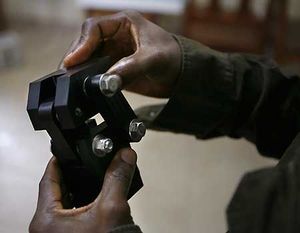
Problem being addressed[edit | edit source]
80 percent of the amputees in the world live in developing countries. Common causes of amputation are war, landmines, car accidents, industrial or farming related accidents, natural disasters, and lack of health awareness, which leads to diabetes, gangrene, and infection. The recent earthquake in Haiti has led to over 100,000 new amputees. When a person loses a limb, they are faced with emotional and financial lifestyle changes.
The cost of a prosthetic limb in a developing country is found to range from $125 to $1875 USD. The cost of a prosthetic limb in the USA ranges from $5,000-$15,000 USD (Berry 2005).
Detailed description of the solution[edit | edit source]
The LEGS M1 prosthetic knee is a durable and cost-effective knee that can be produced locally with simple tools in developing countries. This device has increased tolerance levels and low critical dimensions, which reduces manufacturing defects. Even with manufacturing deviations, this device can function properly. The LEGS M1 Knee has a polycentric design, and uses Delrin Plastic as the knee material. The joints and other connections are made with common stainless steel bolts and each knee costs about $20 USD to manufacture.
Designed by[edit | edit source]
- Designed by: LeTourneau University Empowering Global Solutions (LEGS) is the creator of the M1 knee. LEGS is now LIMBS International.
- Manufacturing: Kenya, Sierra Leone, Bangladesh and Senegal
When and where it was tested/implemented[edit | edit source]
The M1 Knee has been produced and utilized in over a dozen clinics in Kenya, Sierra Leone, Bangladesh and Senegal. LEGS intends to set up centers in India, South America, and the Middle East. LEGS also set up its first center in Kenya in 2005. The LEGS centers around the world do more than just provide prosthetics. They teach the clinicians how to manufacture the knee so that they have successfully been manufactured and fit patients on their own, achieving the model of self-sustainability.
"The knee has been extensively tested, and was held to ISO 10328 standards for lower limb prosthetic testing. The M1 knee has successfully demonstrated compliance in the principal static torsion and fatigue tests at the highest (P5) loading level held by ISO standards. The LEGS M1 Knee is, to our knowledge, currently the only locally produced prosthetic knee available in the developing world that meets ISO standards" (Stanfield 2010).
References[edit | edit source]
Externally generated reports[edit | edit source]
Berry, Dale. From Land mines to Lawn Mowers Prosthetic Rehabilitation Proceeds One foot at a Time. August 2001. The Washington Diplomat. 19 January 2005. Online article no longer available.
Goodier, R. S. (2010, March 13). A durable, cheap prosthetic knee. Link available here.
Stanfield, M. (2010, February). R&d ethics: The case of the $20 knee. Link available here.